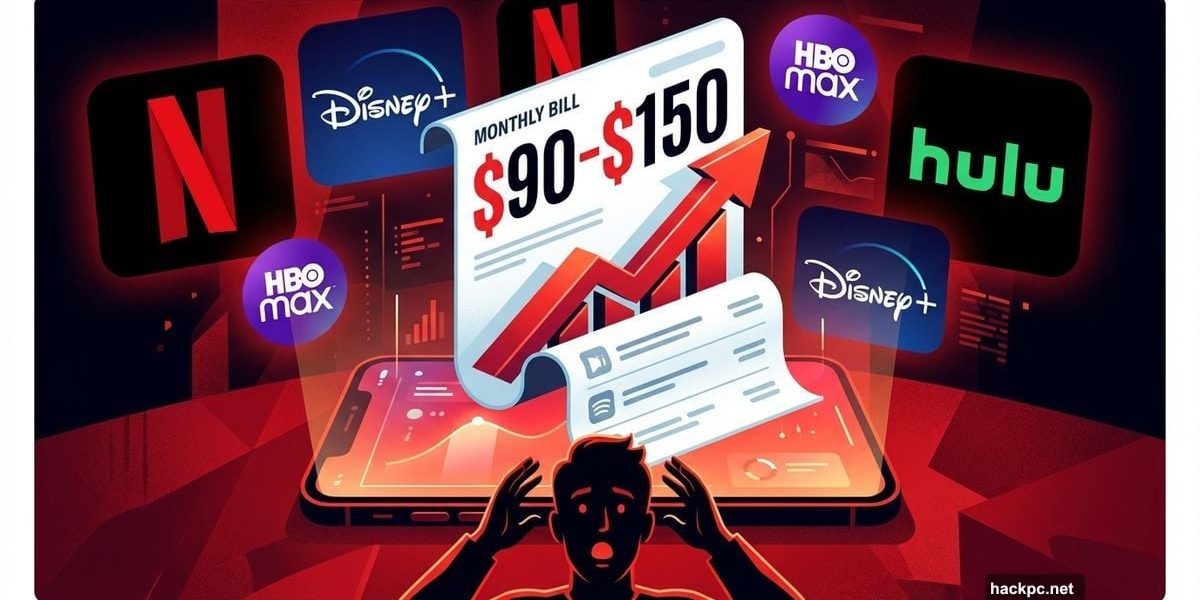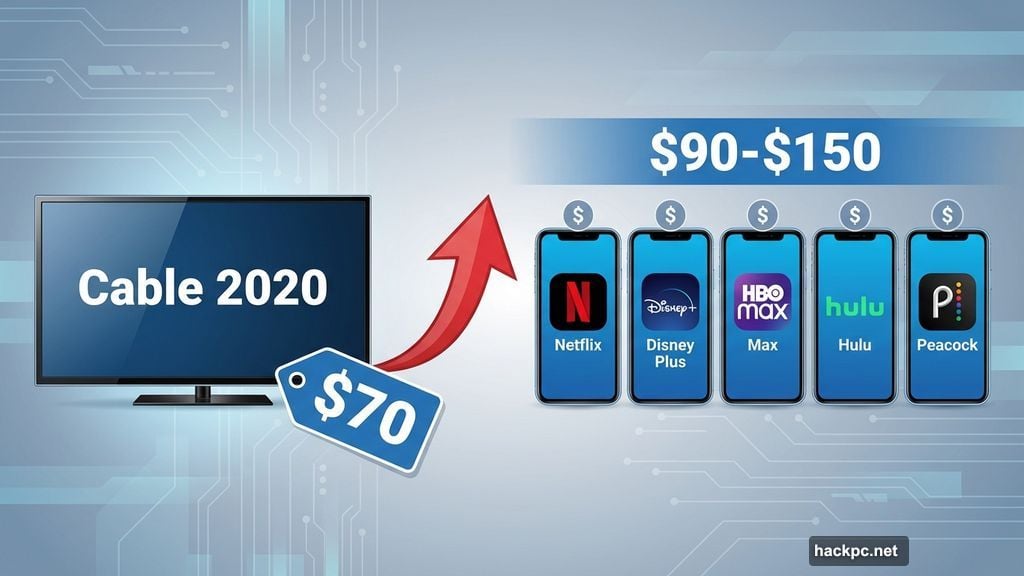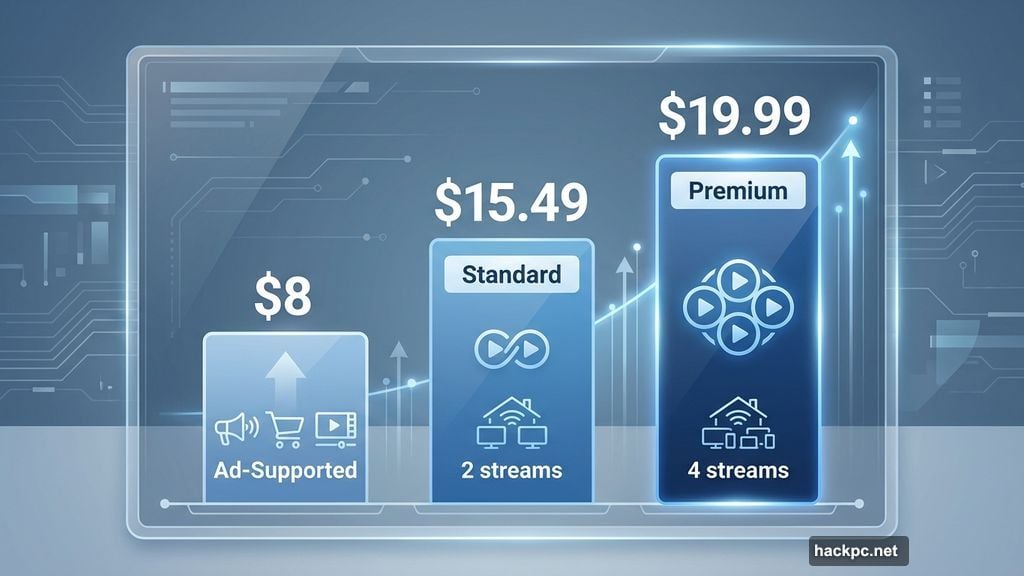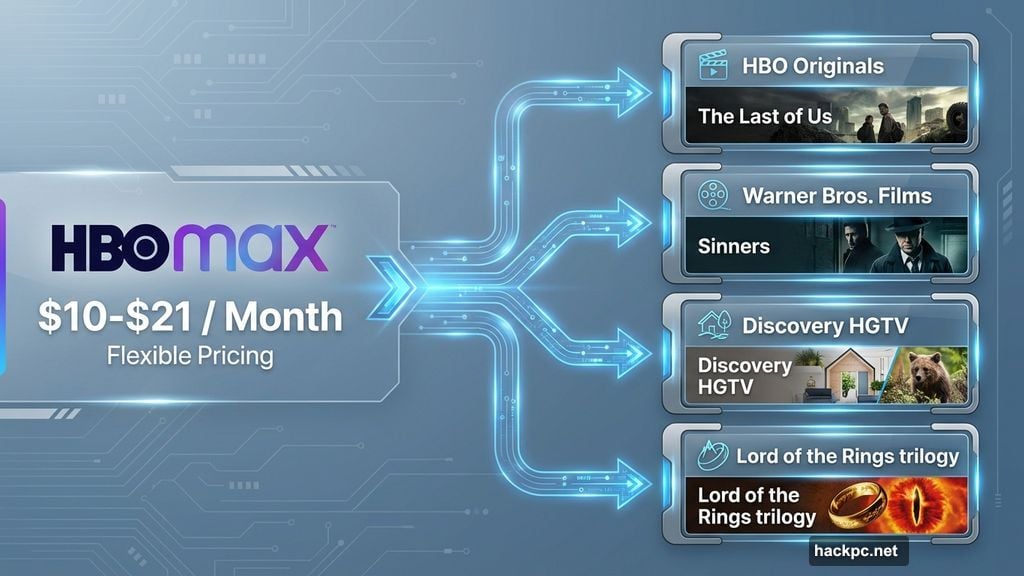
Your streaming subscriptions cost more than cable did five years ago. Most households pay $90-$150 monthly across multiple platforms.
So which services deserve your money in 2025? We tested eight major streamers to find out. Plus, we tracked price hikes, measured ad loads, and counted how many times apps crashed during playback.
Here’s what actually matters when you’re choosing where to spend.
Netflix Still Dominates Despite Price Hikes
Netflix remains the streaming gold standard. But it’s expensive now.
The ad-supported tier costs $8 monthly. That’s reasonable. However, the ad-free Standard plan jumped to $15.49, and Premium runs $19.99. Those prices sting compared to rivals.
What you get for that money: Squid Game, Stranger Things, Wednesday, and Bridgerton. Netflix drops more original content weekly than any competitor. Plus, its recommendation algorithm actually works.
Moreover, Netflix added live events like WWE Raw and expanded its gaming library. Those extras justify the cost if you watch regularly. But casual viewers might find better value elsewhere.
The platform allows two simultaneous streams on Standard and four on Premium. That’s comparable to Disney Plus and HBO Max. However, Netflix now charges extra fees for password sharing outside your household.
Disney Plus Became Surprisingly Expensive
Disney Plus used to be the budget-friendly family option. Not anymore.
The ad-based plan costs $12 monthly now. That’s more than Netflix’s ad tier, HBO Max, and Peacock. The ad-free version runs $19 monthly, matching Netflix Premium’s price.
Why pay that much? Disney Plus remains the only place streaming Pixar films, Marvel shows, and Star Wars series. Titles like Andor, Daredevil: Born Again, and Bluey draw millions of viewers weekly.
However, Disney releases originals slower than Netflix. You’ll wait longer between new episodes of favorite shows. Plus, Disney also charges optional fees for account sharing.
The best value comes from bundles. A basic Disney Plus and Hulu package costs $13 monthly with ads. For $20, you get both ad-free. Triple bundles adding ESPN Select range from $20-$45 monthly depending on ad preferences.
One thing stands out: Disney Plus plans to merge with Hulu in early 2026. That consolidation should improve navigation and reduce app-switching frustration.
HBO Max Delivers Premium Content at Premium Prices
HBO Max costs $10 monthly with ads or $17-$21 ad-free. Those prices land at the high end of streaming options.
What makes it worthwhile? HBO’s entire catalog, including The Last of Us, The White Lotus, and House of the Dragon. Plus, you get Warner Bros. films shortly after theatrical release.
We watched Sinners, Mickey 17, and the complete Lord of the Rings trilogy on the platform. HBO Max also includes Discovery content from HGTV, TLC, and Food Network. That variety matters for households with different viewing preferences.
The B/R Sports tier comes bundled with ad-free premium plans. You can stream live MLB, NHL, and NBA games without paying extra. That’s a significant perk competitors don’t match.
However, HBO Max regularly removes beloved content without warning. Entire Looney Tunes collections disappeared overnight. That instability frustrates subscribers who lose access to favorite titles.
Hulu Works Best for Network TV Fans
Hulu costs $12 monthly with ads or $19 ad-free. The pricing matches its direct competitors.
Its strength lies in next-day access to network shows. New episodes from ABC, Fox, and FX appear hours after broadcast. So you can watch Abbott Elementary, The Handmaid’s Tale, and Shogun without cable.
Plus, Hulu offers strong original content like Only Murders in the Building and Prey. The platform added more anime recently and expanded its movie library with Searchlight and 20th Century Studios titles.
We found Hulu’s interface occasionally frustrating. Menus sometimes glitch during navigation. Plus, regional restrictions prevent access outside the US.

The platform plans to merge into the Disney Plus app next year. That consolidation should resolve some interface issues. For now, you can access Hulu content within Disney Plus if you subscribe to both services.
Prime Video Defaults to Ads Unless You Pay Extra
Prime Video now shows ads by default. You can pay $3 monthly to remove them.
The ad breaks run shorter than Hulu or Paramount Plus. We timed commercial interruptions averaging 60-90 seconds compared to 2-3 minutes on other platforms. That matters during binge sessions.
Prime Video includes quality originals like The Boys, Fallout, and Invincible. Plus, you get Thursday Night Football and exclusive NFL games. The movie library spans older classics and recent releases.
However, navigation remains confusing. Free content mixes with rentals and subscription add-ons like HBO Max or Paramount Plus. The recent redesign improved labeling, but you’ll still click titles only to discover they cost extra.
Prime Video costs $9 monthly standalone or comes free with Amazon Prime membership ($140 annually). That bundled value makes sense if you already use Amazon’s shipping benefits.
Peacock Offers Budget-Friendly Sports and Reality TV
Peacock starts at $8 monthly for basic service with ads. Premium costs $11 monthly (also with ads), while Premium Plus runs $17 ad-free.
The platform streams Sunday Night Football, Premier League soccer, and WWE events live. That sports access alone justifies the cost for many subscribers.
You also get NBC shows like Law & Order, plus Bravo reality hits like Real Housewives and Traitors. Universal films including Wicked, Nosferatu, and The Wild Robot arrive after theatrical runs.
However, Peacock lacks mobile downloads unless you upgrade to Premium Plus. Plus, most content streams in HD, not 4K HDR. Those limitations feel dated compared to competitors.
The service works best as a supplement to other streamers. Pay for Peacock during football season, then cancel when games end. That rotating strategy saves money annually.
Paramount Plus Combines CBS Content With Showtime
Paramount Plus costs $8 monthly with ads or $13 ad-free (including Showtime). Those prices undercut most competitors.
The platform leverages Paramount’s massive brand portfolio. You get CBS shows, MTV reality series, Nickelodeon kids content, and Comedy Central specials. Plus, Taylor Sheridan’s Yellowstone universe shows like 1883, 1923, and Landman.
Showtime integration adds prestige content like Yellowjackets and Billions without paying separately. Paramount Pictures films including Gladiator II and Top Gun: Maverick stream first here after theaters.
We found Paramount Plus has fewer originals than Netflix or HBO Max. Outside Star Trek series, Evil, and Sheridan’s shows, original content feels limited.
The service offers decent value for nostalgia viewing. You can watch old Nickelodeon shows, Frasier reruns, and SpongeBob SquarePants episodes endlessly. That library depth matters for families with young kids.
Apple TV Plus Focuses Exclusively on Prestige Originals
Apple TV Plus costs $13 monthly with no ads. The service includes only original content—no back catalog of older shows or movies.
What you get: Ted Lasso, Severance, Slow Horses, and Pachinko. All titles stream in 4K HDR with Dolby Vision and Dolby Atmos. That premium quality matches theatrical presentation.
However, the library remains small. Apple offers roughly 100 original shows and movies total. That’s a fraction of what Netflix or Disney Plus provides.
The platform works best for quality-over-quantity viewers. If you watch one prestige show weekly instead of binge-watching constantly, Apple TV Plus delivers excellent value.
Plus, Apple offers multiple free trial options. College students, new Apple device buyers, and Apple One bundle subscribers can access months of free service. That makes trying it risk-free.
Bundle Deals Cut Costs Significantly

Most streamers offer bundles now. Those packages save real money compared to separate subscriptions.
Disney’s triple bundle (Disney Plus, Hulu, ESPN Select) costs $20 monthly with ads or $30 ad-free. Buying separately would run $32-$55 monthly. That’s $12-$25 in monthly savings.
Xfinity’s StreamSaver packages Netflix, Peacock, and Apple TV Plus together at discounted rates. Similar bundles exist through Verizon and T-Mobile for wireless customers.
One standout deal combines HBO Max, Hulu, and Disney Plus for $20 monthly with ads or $33 ad-free. That package delivers the most content variety for the lowest combined price.
However, bundles lock you into multiple services. You can’t easily cancel one without losing bundle pricing. So only bundle services your household actually watches regularly.
Ads Keep Getting Longer and More Frequent
We measured ad loads across platforms. The results vary dramatically.
Hulu runs the longest commercial breaks—averaging 2-3 minutes during hour-long shows. Paramount Plus follows closely with 2-minute interruptions.
Netflix and Disney Plus show shorter ad breaks, typically 60-90 seconds. However, both platforms exclude some titles from ad-supported tiers entirely. So you’ll hit paywalls for certain content.
HBO Max limits ads to 4 minutes per hour maximum. That’s the lightest ad load among ad-supported streamers. Plus, HBO never shows ads on kids’ profiles, unlike Netflix and Disney Plus.
Prime Video’s ads run shortest—usually under 60 seconds. But Amazon’s default assumption that everyone accepts ads feels aggressive compared to opt-in ad tiers elsewhere.
Simultaneous Streams Matter for Households
Most services allow 2-4 simultaneous streams. That matters when multiple people watch at once.
Netflix limits ad-tier users to two streams. You need Premium ($19.99 monthly) for four streams. Disney Plus also restricts to four streams maximum.
Prime Video allows three simultaneous streams. Peacock matches that. However, HBO Max limits users to just two screens simultaneously unless you pay for the premium tier.
Apple TV Plus leads with six concurrent streams. That’s overkill for most households but useful for large families.
Consider your household’s viewing patterns. If everyone watches different shows at different times, you’ll need higher stream limits. Otherwise, you’ll face “too many devices” errors constantly.
Interface Design Affects Daily Experience
We tested each app on Roku, Fire TV, Apple TV, and mobile devices. Interface quality varies widely.
Netflix offers the cleanest design. Its recommendation rows surface relevant content quickly. Plus, the “continue watching” section syncs perfectly across devices.
Disney Plus improved recently with clearer hub navigation. You can easily jump between Disney, Marvel, Star Wars, and Nat Geo content. The upcoming Hulu merger should streamline things further.
HBO Max excels at highlighting new releases. The home screen always surfaces latest episodes at the top. However, search functionality sometimes glitches.
Paramount Plus feels cluttered. Too many tiles compete for attention. Plus, finding specific older shows requires excessive scrolling through category pages.
Prime Video remains the most confusing. Mixing free, rental, and subscription content on the same screen creates constant frustration. Even after their redesign, navigation feels messy.
4K and HDR Support Still Isn’t Universal
Most services now offer 4K HDR streaming—but with caveats.
Apple TV Plus streams everything in 4K HDR with Dolby Vision and Atmos. That’s the highest quality available. Netflix and Disney Plus match that quality on their premium tiers.

HBO Max offers limited 4K content. Most shows stream in HD only. Paramount Plus has even less 4K availability outside major originals.
Peacock barely supports 4K at all. Only select Premier League soccer matches and Sunday Night Football broadcasts stream in ultra-high definition.
Moreover, 4K requires more bandwidth. You’ll need 25+ Mbps internet speeds for stable playback. Plus, 4K content consumes significantly more data if you’re watching on mobile with limited plans.
Mobile Downloads Work Differently Across Services
Most streamers let you download content for offline viewing. But policies vary.
Netflix, Disney Plus, HBO Max, and Hulu all allow unlimited downloads on mobile devices. Those downloads expire after varying periods—typically 30 days for most titles.
Prime Video limits downloads to 25 titles simultaneously. That’s adequate for most users but restrictive for long trips.
Peacock only offers downloads on its Premium Plus tier ($17 monthly). Basic and Premium subscribers can’t download anything. That’s a major limitation for commuters.
Apple TV Plus allows downloads but requires active subscription status. If your payment lapses, downloaded content becomes inaccessible immediately.
Kids’ Content Varies Dramatically By Platform
Disney Plus dominates kids’ programming. The entire Disney, Pixar, and Marvel catalog lives there. Plus Bluey, which attracts millions of young viewers.
Netflix offers strong kids’ content with CoComelon, Gabby’s Dollhouse, and animated films. However, some kids’ titles get excluded from the ad-supported tier.
Paramount Plus includes Nickelodeon’s entire library. That means SpongeBob, Paw Patrol, and Teenage Mutant Ninja Turtles. For nostalgia-loving parents, that’s gold.
HBO Max has decent kids’ selections but nothing comparable to Disney. Hulu’s kids’ section feels limited unless bundled with Disney Plus.
Apple TV Plus barely caters to kids. A handful of original shows exist, but families need additional services for comprehensive children’s programming.
Live Sports Changed Streaming Permanently
Sports increasingly drive streaming subscriptions. But accessing your favorite teams requires research.
Peacock streams Sunday Night Football and Premier League soccer exclusively. That’s the cheapest option for NFL fans who only care about Sunday nights.
Prime Video handles Thursday Night Football. Plus Amazon secured some MLB and WNBA games. For $9 monthly, that’s solid sports value.
HBO Max’s B/R Sports tier includes MLB, NBA, and NHL games. However, that’s only included on premium plans ($17-$21 monthly). Ad-supported subscribers don’t get live sports access.
Apple TV Plus signed Formula 1 rights starting 2026 and currently streams Major League Soccer. That’s a limited but growing sports portfolio.
Most major sports still require multiple subscriptions or cable. Streaming hasn’t replaced cable for sports fans—it just added more bills.
Rotating Subscriptions Saves Money
You don’t need every service simultaneously. Rotating subscriptions cuts annual costs significantly.
Subscribe to Netflix for three months while Stranger Things drops new episodes. Then cancel and switch to Disney Plus when Andor returns. Rotate to HBO Max when The Last of Us airs.
This strategy requires discipline. You’ll lose access to some content between subscription periods. But you can save $500+ annually compared to maintaining all services year-round.

Most platforms don’t penalize cancellations. You can resubscribe anytime without losing watch history or preferences. That makes rotating painless.
The only exception: Annual subscriptions. Some services offer discounts for yearly commitments, but that locks you in. Avoid annual plans unless you’re certain you’ll watch consistently.
Free Trials Mostly Disappeared
Remember when every streaming service offered 30-day free trials? Those days ended.
Most platforms eliminated free trials entirely. Netflix, Disney Plus, and Hulu no longer offer risk-free testing periods for new subscribers.
HBO Max occasionally runs promotional free trials. Paramount Plus sometimes offers extended trials through partners like Walmart Plus.
Apple TV Plus remains the exception. The service still offers lengthy free trials for students, new device buyers, and Apple One subscribers. Those trials can last 3-6 months.
Your best option: Wait for promotional deals during Black Friday, Cyber Monday, or back-to-school seasons. Services temporarily discount subscriptions or extend trials during major shopping events.
Original Content Quality Matters Most
Back catalog matters less than it used to. Most viewers subscribe for original content now.
Netflix produces more originals than any competitor. Not everything hits, but volume increases chances you’ll find something compelling weekly.
HBO Max maintains the highest average quality. Nearly every HBO original feels premium and well-produced. But release frequency lags behind Netflix.
Disney Plus releases originals sporadically. You might wait months between new Star Wars or Marvel series episodes. That makes staying subscribed year-round harder to justify.
Apple TV Plus publishes the fewest originals. But nearly everything they release earns critical acclaim. If you prioritize quality over quantity, Apple delivers.
Regional Restrictions Still Frustrate Travelers
Most streaming services restrict access by location. That creates problems for international travelers.
Netflix offers different content libraries by country. Your US subscription works abroad, but available titles change based on location.
Hulu blocks access entirely outside the US. You can’t watch anything while traveling internationally without a VPN.
Disney Plus and HBO Max maintain some international availability. However, content libraries shrink significantly in many countries.
Apple TV Plus and Prime Video work globally with minimal restrictions. That makes them the most reliable options for frequent travelers.
Should You Actually Subscribe?
It depends on what you watch and how much you watch.
If you binge-watch constantly, Netflix or Disney Plus make sense despite higher prices. The content volume justifies monthly costs.
For casual viewers who watch 1-2 shows weekly, pick one service with your favorite content. Apple TV Plus or Paramount Plus offer quality at reasonable prices.
Sports fans need Peacock or Prime Video at minimum. Add ESPN Plus separately for comprehensive sports coverage.
Families with young kids must keep Disney Plus. Nothing else compares for children’s content.
The real answer: You probably don’t need all eight services. Pick 2-3 that match your household’s viewing habits. Cancel the rest. Your wallet will thank you.



Comments (0)